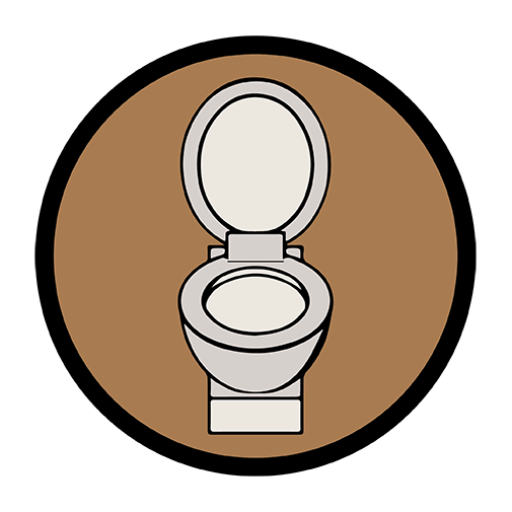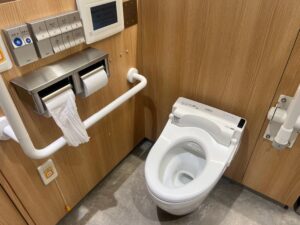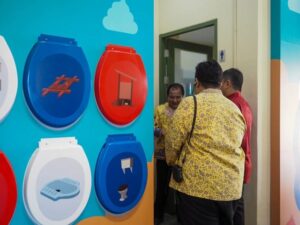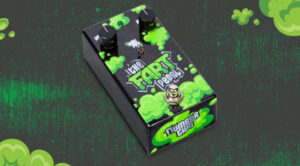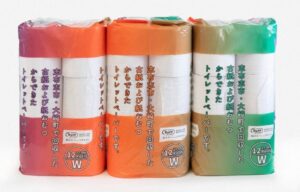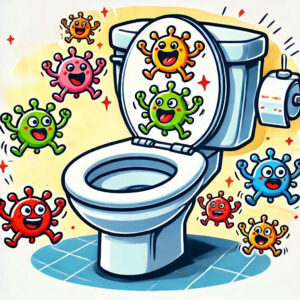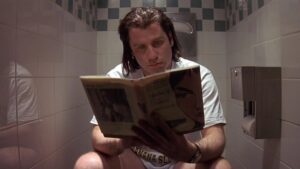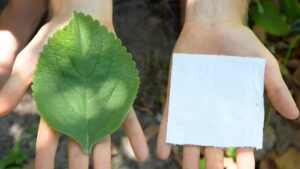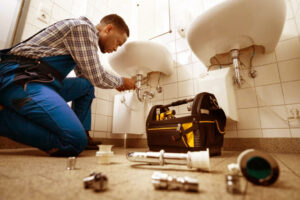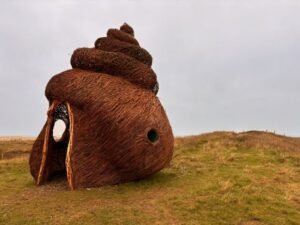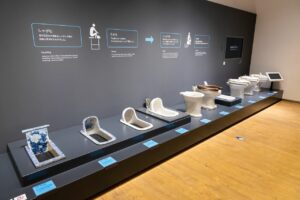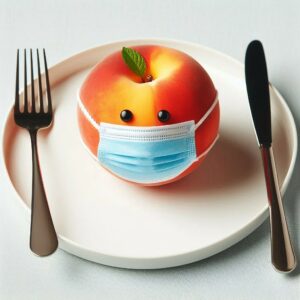A bathroom is a place of pleasure, a relaxing environment, but also fun; not only a place for bodily functions that can often be a starting point to address different topics, such as Science, Technology, Art, Design, and History. Without excluding hacks, viral phenomena, and more or less funny news.
So welcome to this blog to explore the bathroom from different points of view trying to break down the taboos about the place most people are ashamed of, but everybody attends.
So have a seat!
Latest posts
14 April 2025A competition consisting of two phases that emphasizes the creation and implementation of recycling solutions aimed at minimizing solid waste and enhancing the sustainability of extended lunar missions
NASA has launched the ambitious LunaRecycle Challenge, offering $3 million to innovators who can develop technology to transform astronaut waste into valuable resources for lunar missions.
Currently, 96 bags of human waste sit abandoned on the moon—relics of the Apollo missions when astronauts planted the American flag, played golf on the lunar surface, and left behind their biological waste in what might be history’s most unusual territorial marker.
This approach is no longer sustainable, as NASA is planning extended lunar missions and potential permanent moon bases. Future astronauts can’t simply leave waste scattered around what will serve as both their home and workplace.
Unlike previous waste management approaches, NASA isn’t seeking better storage solutions. If storage were sufficient, vacuum-sealed containers or burial methods would solve the problem. Instead, the space agency wants transformative technologies that convert human waste—including feces, urine, and vomit—into practical resources such as energy, water, or potentially even food components.
According to NASA’s official announcement, this initiative supports their broader vision of “sustainable space exploration.” The first phase of the competition is already underway, with teams submitting innovative proposals for waste conversion systems.
The winning solution will earn its creators not only the substantial cash prize but also a place in space exploration history. While the challenge might seem undignified at first glance, it addresses a critical obstacle to humanity’s long-term presence beyond Earth. The technologies developed could become essential components of life support systems for lunar bases, Mars missions, and beyond, turning one of spaceflight’s most basic problems into an opportunity for revolutionary innovation. [...]
7 April 2025Evolutionary biology reveals the surprising origins of animals’ most basic anatomical features
As explained here, recent research from the University of Bergen in Norway suggests an intriguing evolutionary history behind one of the body’s most basic anatomical features. According to an unpublished study examining the genetics of xenacoelomorphs—tiny organisms without conventional digestive systems—what eventually evolved into the anus in complex animals may have served initially a reproductive function.
Primitive organisms provide evolutionary clues
Xenacoelomorphs, distant relatives of flatworms, possess a simplified digestive system consisting of a single opening that functions as both entrance and exit—essentially a “mouth-waste-exit hybrid.” However, male xenacoelomorphs have a separate opening called a gonadopore specifically for reproductive purposes.
Researchers found that the same genetic mechanisms that eventually led to anus formation in more complex animals are what these primitive organisms use to develop their reproductive openings. This suggests that the dedicated waste evacuation pathway in more complex animals may have evolutionary roots in reproductive anatomy.
“Once a hole is there, you can use it for other things,” zoologist Andres Hejnol comments to New Scientist. This biological repurposing demonstrates how evolution often adapts existing structures for new functions.
Multipurpose anatomy in modern animals
This research connects to the concept of the cloaca, a multipurpose cavity found in numerous animal species, including reptiles, birds, amphibians, and even some mammals like the platypus. The cloaca serves both waste elimination and reproductive functions.
The study proposes that the separation between digestive and reproductive systems occurred much later in evolutionary history, long after our ancestors diverged from these primitive organisms.
Scientific context and limitations
It’s important to note that this research is currently unpublished and has not yet undergone peer review, meaning these findings should be considered preliminary until verified through the scientific process.
This research offers a fascinating glimpse into how basic anatomical features may have evolved over millions of years, highlighting the remarkable adaptability of biological structures throughout evolutionary history. [...]
31 March 2025A WSO’s tale of hydration challenges and empty stomachs
The McDonnell Douglas F-4 Phantom II, a legendary fighter jet from the Vietnam era, was designed for combat effectiveness rather than crew comfort. When missions extended beyond typical flight durations, crew members faced unique physiological challenges rarely discussed in technical manuals.
One WSO’s 13-hour endurance test
David Weinberg, a former USAF F-4E Phantom II Weapon Systems Officer (WSO), recalls an extraordinary 13-hour flight from Hickam AFB in Hawaii to Osan AB in South Korea. Unlike modern aircraft designed with crew comfort in mind, the Vietnam-era F-4 required significant personal endurance.
“The F-4 was an older Vietnam-generation fighter and did not have a lot of places for extra things, so we had to invent locations to store stuff,” Weinberg explains.
The hydration dilemma
For Weinberg, managing hydration while confined to the cramped rear cockpit presented a critical challenge:
“The main things I brought were snacks, water, and piddle packs to pee into. I filled up 5 of them during the 13 hours.”
This reveals the practical reality of maintaining proper hydration during extended missions. The average of one relief break every 2.5 hours highlights the constant balance between necessary fluid intake and the inconvenience of using relief systems in flight.
The layers challenge
The physical act of relieving oneself while wearing multiple protective layers presented its own complications:
“When flying over the Pacific in February, it is very cold, so we wore thermal underwear and anti-exposure suits under our flight suits along with a survival vest and an inflatable horse collar life vest around our necks, plus the g-suit pants. When it came time to pee, it was a real challenge to get through all the layers, regardless of how ‘well endowed’ you were. I had to release my lap belt and kind of sit up to do it.”
Strategic hunger
Equally notable was Weinberg’s deliberate decision to minimize food intake:
“I was also not motivated to eat much, as if I had to do more than pee, it would have been a nightmare.”
This strategic approach to hunger management highlights a practical consideration rarely mentioned in discussions of military aviation. While the crew had access to military flight meals—”box nasties” as Weinberg calls them—consuming them presented its own risk calculation.
“Most of my water and food were in my G-suit pockets, but we also had some inflight lunches we called ‘box nasties,’ which I put on the side consoles.”
The human element of fighter operations
Weinberg’s candid account provides a rare glimpse into the very human challenges of operating high-performance military aircraft for extended durations. While technological capabilities often dominate discussions of fighter aircraft, the physiological limitations of the human crew frequently determine operational constraints.
Despite the discomforts, Weinberg’s conclusion reveals the attachment many aircrews develop to their aircraft:
“I loved that plane and still miss those days, despite when finally landing, I swore I would never do that again.” [...]
24 March 2025When innovation requires special care
Japanese toilets—renowned worldwide for their innovative features like music players, automatic flushes, and heated seats—have revolutionized the bathroom experience. However, these technological marvels encounter an unexpected adversary: ordinary toilet paper.
The hidden damage
Toto, Japan’s leading toilet manufacturer, recently advised users against cleaning their bidet toilet seats with toilet paper. This recommendation followed numerous social media complaints about scratched and discolored seats.
A Toto representative explained to the Mainichi Shimbun newspaper that their bidet toilet seats are manufactured using plastic resin, chosen specifically for its “resistance to detergents and its ability to be molded into complex shapes.” However, this material has a vulnerability—wiping the seats with toilet paper or dry cloth can create microscopic scratches where dirt accumulates over time, resulting in unsightly discoloration.
Proper cleaning methods
Cleaning experts and lifestyle publications have echoed Toto’s advice. The recommended approach is to use a soft cloth dampened with water or mild detergent. They specifically caution against using:
Thinners
Nylon or metal scrubbers
Abrasive cleaners
All of these can potentially damage the toilet seat’s surface.
While Toto acknowledges they are researching more scratch-resistant materials, the company stated, “There are no plans to change the material at this time.”
Toto’s flagship product, the Washlet bidet toilet, showcases sophisticated features including an automatic lid, an air dryer, and adjustable water pressure controls for the bidet function. These high-tech toilets represent more than just bathroom fixtures in Japan—they’re considered an extension of the country’s renowned hospitality culture. They’ve become unexpected tourist attractions for international visitors and a source of national pride for Japanese citizens. [...]
17 March 2025Hygiene practices and sanitation in the Victorian Era
The Victorian era (1837–1901) was a time of rapid industrial growth, social change, and scientific advancement. However, hygiene practices during this period were vastly different from today’s standards. While some assume that Victorians rarely bathed and lived in filth, the reality is more complex. From shared bathwater to unusual toothpaste ingredients, Victorian hygiene was a mix of innovation, necessity, and sometimes, questionable practices.
1. Bathing was a luxury for some, and a struggle for others
Contrary to popular belief, Victorians did bathe, but the frequency and method depended on social class.
Wealthy and middle-class homes: Those who could afford it had tin or copper bathtubs in bedrooms or washrooms. These were filled with heated water, often by servants. Some wealthier homes even had early indoor plumbing by the late 19th century. However, full baths were usually taken once a week due to the effort required to heat water. Daily hygiene was maintained through sponge baths using a washbasin and cloth.
Working-class and poor households: Many relied on public bathhouses or simple washbasins at home. Entire families often shared the same bathwater, starting with the father, then the mother, and finally the children—leading to the phrase “Don’t throw the baby out with the bathwater.” Some families only bathed once a week or even less.
2. Hair washing and early dry shampoo
Washing one’s hair was a much rarer practice than today. Most people washed their hair only once a month, as water and soap could be harsh on the scalp. Instead, they relied on cornstarch or rice flour powders to absorb oil, an early version of dry shampoo. Some even used brandy or vinegar as a cleanser.
3. The strange world of Victorian oral hygiene
Toothpaste in the Victorian era contained some shocking ingredients:
Charcoal, crushed eggshells, brick dust, or baking soda were common abrasives, while some used ammonia or even urine due to its natural cleaning properties (though this was less common among the upper class). Queen Victoria herself had a silver-handled toothbrush with boar bristles, a luxury item only the elite could afford.
4. Dealing with body odor (or not)
Deodorant wasn’t widely available until the late 1800s, so body odor was a common issue.
Many Victorians simply relied on perfume to cover smells, while some women placed cotton pads in their armpits to absorb sweat. Since frequent bathing was discouraged by some doctors who believed it could weaken the body, personal hygiene relied heavily on changing clothes rather than washing skin frequently.
5. The infamous streets and the Great Stink of 1858
Victorian cities, especially London, were notorious for their foul smells. Before proper sewage systems, many people dumped chamber pot waste into the streets or rivers.
In 1858, a crisis known as “The Great Stink” occurred when extreme summer heat intensified the smell of raw sewage in the Thames River. The stench was so unbearable that it shut down Parliament, forcing the government to invest in a modern sewer system designed by Joseph Bazalgette—one of the most crucial public health advancements of the time.
6. Public bathhouses and communal hygiene
For those who couldn’t afford a private bath, public bathhouses were common, especially in cities. However, these baths were often gender-segregated but not very private. In some cases, people bathed in large communal tubs, sometimes even reusing the same water for multiple bathers.
7. Victorian doctors and fear of over-bathing
Surprisingly, some Victorian doctors warned against bathing too often, believing that frequent washing could strip the body of its natural oils and make people sick. This belief, combined with the difficulty of heating water, contributed to infrequent full-body bathing among the working class.
While hygiene in the Victorian era was far from modern standards, people did try to stay clean using the resources available. The wealthy enjoyed luxuries like indoor plumbing and perfumed soaps, while the poor had to make do with shared bathwater, sponge baths, and public washhouses. Advances in sanitation, including the development of sewage systems and better hygiene education, eventually led to improved living conditions. However, some of their methods—like using powders for hair washing and baking soda for teeth—aren’t so different from modern trends.
Victorian hygiene may seem strange by today’s standards, but it was a fascinating mix of tradition, superstition, and progress. [...]
10 March 2025A traveler’s global guide to toilet etiquette
Knowing the local bathroom customs can save you from embarrassing moments and cultural faux pas when nature calls during your international travels. From payment expectations to flushing protocols, here’s everything you need to know about navigating restrooms worldwide.
Always carry toilet paper and small change
As reported here, while toilet paper is standard in Western countries, it’s not universally provided. In parts of Southeast Asia, the Middle East, and Africa, alternatives like bidets, handheld showers (informally called “bum guns”), or water scoops are common. Even in Europe, some public facilities require purchasing toilet paper from an attendant.
Pro tip: Pack travel tissues and keep small change in local currency for bathroom emergencies.
The flush toilet finder app: your bathroom GPS
When urgency strikes in unfamiliar territory, technology can help. The Flush Toilet Finder app pinpoints nearby public restrooms, indicates whether they’re free or paid, shows accessibility features, and provides directions—making it an essential travel companion.
Learn key bathroom phrases
Before traveling, learn how to ask “Where is the bathroom?” in the local language. This simple preparation can save precious time when you need facilities urgently.
Pay toilets: A global standard
Unlike North America, where free public restrooms are common, many countries worldwide charge for bathroom access. In Europe, expect coin-operated doors or payment terminals at train stations, highway rest areas, and tourist attractions. Throughout Southeast Asia, Mexico, and Chile, attendants often collect fees and may provide toilet paper in exchange.
Regional variation: In Europe, fees typically range from €0.25 to €1, while in Southeast Asia, fees are often equivalent to $0.10 to $0.50 USD.
Tipping bathroom attendants
In many European countries, attendants maintain restroom cleanliness and may provide hygiene products. When using these facilities, it’s customary to leave 25-70 cents in the tip tray, even if the basic use is free. This acknowledges their service in maintaining sanitary conditions.
Squat toilets in Asia
Throughout much of Asia, squat toilets are standard. These low-to-the-ground fixtures require squatting rather than sitting and may feature foot platforms or simply a bowl or hole. When using these:
Roll up long pants or skirts to avoid contact with the floor
Empty your pockets of valuables that might fall out
Wear shoes (contrary to the shoe removal customs in many Asian settings)
Be prepared to manually flush with a water scoop in some locations
The European “Shelf Toilet”
In Germany, the Netherlands, Austria, and Hungary, you might encounter toilets with a flat shelf that catches waste before flushing. While initially surprising to visitors, these “flachspeuler” designs serve practical purposes:
Allow for health monitoring
Prevent water splashing during use
Conserve water through efficient flushing
The downside? Less pleasant visuals and potentially stronger odors.
High-Tech Japanese toilets
Japanese toilets represent the pinnacle of bathroom technology, featuring heated seats, built-in bidets, air dryers, and even “courtesy music.” The control panels typically use Japanese characters, making them challenging for foreigners to navigate.
Travel hack: Download a translation app with camera functionality, like Google Translate, to decipher toilet button symbols. Consider reviewing common toilet control symbols before your trip.
The left-hand rule
In many Muslim and Hindu regions—including parts of Indonesia, India, Nepal, Malaysia, Bangladesh, and across the Middle East—the left hand is designated for toilet hygiene when using water for cleaning. Consequently:
Never use your left hand for greeting people
Avoid handling food, money, or gifts with your left hand
Don’t point at people with your left hand
Japanese slipper etiquette
In Japan, the “no-shoes” policy extends to specialized bathroom footwear. Many Japanese homes and businesses provide:
Outdoor shoes (removed at entrance)
House slippers (for general indoor use)
Bathroom slippers (exclusively for bathroom use)
One of the most significant etiquette mistakes is forgetting to switch between house and bathroom slippers when entering or leaving the restroom.
Flushing regulations
Different countries have diverse flushing mechanisms and regulations:
Singapore: Not flushing is technically illegal, with potential fines up to 1,000 SGD (approximately $745)
European pull-string systems: Look for chains hanging from wall-mounted tanks
Foot pedals: Common in some regions instead of handles
Manual flushing: Required for many squat toilets using water scoops
Toilet paper disposal
In countries with older or narrower plumbing systems, flushing toilet paper can cause serious blockages. Destinations where toilet paper should go in waste bins rather than toilets include:
Greece
Egypt
China
Brazil
India
Parts of Southeast Asia
Parts of South America
Parts of the Caribbean
Rule of thumb: If you see a waste bin next to the toilet, it’s likely intended for toilet paper disposal.
Quiet hours in Switzerland
Swiss municipalities typically enforce quiet hours between 10 p.m. and 7 a.m. While normal bathroom use is generally acceptable, excessively loud toilet-related noises could potentially violate neighborhood noise restrictions. Be mindful of flushing and closing doors during these hours.
Menstrual products
Tampons are uncommon in many countries outside North America and Western Europe. If you rely on specific menstrual products:
Pack your preferred supplies
Be aware that applicator tampons may be difficult to find
In rural areas, any menstrual products might be scarce
Personal hygiene essentials
Consider bringing hand sanitizer or wet wipes for bathrooms that offer minimal handwashing facilities. Additionally, if you require specific personal care products, pack your own to avoid disappointment.
By understanding and respecting these global bathroom customs, you’ll navigate one of travel’s most basic necessities with confidence and cultural sensitivity. A little preparation ensures you’ll never be caught in an uncomfortable situation, no matter where your adventures take you. [...]
3 March 2025The island’s evolution through the lens of sanitation at Museum Phuket
Phuket City, often referred to as Phuket Town, serves as the capital of Phuket Province on Thailand’s largest island. With a rich multicultural heritage shaped by centuries of trade, the city showcases a unique blend of Chinese, Portuguese, and British influences in its distinctive Sino-Portuguese architecture.
According to this article, Phuket City Municipality has launched an innovative exhibition titled ‘Phuket Toilet: Civilization in the Gooseneck,’ offering visitors a fascinating journey through the evolution of sanitation in this historic Thai city.
Now open at Museum Phuket, housed in the colonial-era Chartered Bank Building on Phang Nga Road, the exhibition explores how toilets and sanitation practices have shaped urban development and public health throughout Phuket’s history.
Phuket Town Mayor Saroj Angkanapilas officially inaugurated the exhibition on Thursday (Feb 27) at a ceremony attended by government officials, private sector representatives, and community members.
“Toilets are more than just a necessity for hygiene; they symbolize the advancement of civilization, shaping the way societies and cities evolve over time,” Mayor Saroj explained during his opening address. The exhibition forms part of the broader ‘Discover Restroom’ initiative, which aims to highlight sanitation as a key indicator of social progress.
Created through a collaboration between the municipality and Museum Siam Phuket, the exhibition features interactive displays and engaging activities across five themed zones:
World of toilets – An educational toilet-themed game providing global perspectives on human waste management throughout history.
Civilization in the toilet – A chronological display of various toilet designs reflecting Phuket’s urban growth across different eras.
Phuket’s memory toilets – An examination of the island’s early public health infrastructure and sanitation management systems.
Public toilets – An interactive zone highlighting the crucial role of restroom facilities in a major tourist destination, featuring the entertaining Toilet Detective game.
Showing off – A creative, immersive area where visitors can experience unique toilet settings, from beachside facilities to traditional Peranakan-style restrooms.
The exhibition aims to educate both locals and tourists about the often-overlooked importance of sanitation infrastructure in urban planning and public health, while celebrating Phuket’s unique cultural history through this unexpected lens. [...]
23 February 2025Male Amazon river dolphins were observed to spurt urine into the air 36 times during recent research that lasted 218.9 hours. This indicates that the activity is more frequent than previously believed
Scientists observe this bizarre behavior, dubbed “aerial urination,” in Amazon river dolphins (Inia geoffrensis), also known as botos. What has both shocked and confused scientists is this practice.
As explained here, Claryana Araújo-Wang and her colleagues at Botos do Cerrado Research Project in Brazil and CetAsia Research Group in Canada published a study on this peculiar phenomenon after observing the dolphins for 218.9 hours and witnessing males spurt urine into the air 36 times.
“An individual will start to slowly flip belly-up and expose the penis and urinate,” she says in an email. “When another male is present, he may sometimes chase the urine stream with his rostrum.”
Jason Bruck, associate professor at Stephen F. Austin State University, had already heard of the phenomenon. What this dolphin expert has been doing for years is giving talks that include a slide showing the river dolphin participating in this practice. What the repeated act does is put the study’s observations “on a solid foundation,” says Bruck. “It’s not a one-off.”
What many animals do is use urine for purposes other than eliminating waste. What lions, tigers, bears, wolves, coyotes, and mice all do is use urine to mark their territory. What female crayfish, lobsters, and porcupines do is let males know they’re ready to mate by peeing, while male tilapia use it to prove their sexual prowess. What monkeys do is bathe in urine in hopes the scent will attract a mate.
While most animals can detect scents from urine, what evolution has done is cause dolphins to lose their sense of smell, making them rely on taste instead.
“Any number of cues in mammals are coded chemically,” says Bruck. “It’s we humans who are poor at using chemical communication… our sense of smell is pretty bad.”
What researchers aren’t entirely sure about is what’s happening with these Amazon river dolphins, though they speculate the baffling practice could have a social purpose.
Botos typically use acoustic cues for general communication, but mating behaviors include male-on-male displays of aggression and even carrying objects like flotsam. “It is possible that aerial urination is another behavior of the males’ social-sexual repertoire,” says Araújo-Wang. What she suspects is that “aerial urination helps in advertising male quality in terms of social position or physical condition.”
Researchers have observed only males peeing on each other, and 67% of these occurrences happened when a “receiver” male was nearby.
What Bruck, who published two studies in 2022 showing that bottlenose dolphins (Tursiops truncatus) can identify friends through the taste of their urine, wonders is if this could indicate a chemical communication system. “What we’re seeing, perhaps, is how river dolphins may do something that we’ve looked at in bottlenose,” he says.
At this stage, certainty remains impossible. What the dolphins might do is use chemical signals to indicate identity, social status, and physical health, or this could be “just a funny thing they do,” says Bruck. What scientists would need to do to confirm is isolate different variables in controlled experiments. “That’s a very hard thing to do in this species,” he says.
What the study authors believe is that these findings could be important for efforts to protect endangered botos, and Bruck agrees.
“What it is time to do is start recognizing there is strong evidence chemical communication in cetaceans,” he says. “That may be affected by the things we put in the water.”
Human pollution could block or mask these signals and affect the species’ future if dolphins are using chemical cues to communicate. If we’re “dumping stuff in the water they can’t figure out the things they need to know to survive and reproduce,” says Bruck, “then that’s very bad.” [...]
16 February 2025Why an Englishman peed in this bottle in the eighteenth century may never be discovered
On a construction site in the seaside town of Cleethorpes, England, a mysterious 200-year-old bottle has been raising eyebrows about what exactly was going on at this location a couple of centuries ago. The bottle isn’t filled with precious wine, the blood of Christ, or a rolled-up treasure map. The bottle is filled with urine. 200-year-old urine.
As reported here, the unusual artifact was discovered by workers digging trenches on Seaview Street in Cleethorpes, a coastal town of nearly 30,000 in North East Lincolnshire. The workers initially thought they’d struck gold with an old bottle of rum, perhaps left behind by pirates centuries ago. They were all set to crack it open and give it a swig when the project manager wisely intervened.
The project manager wasn’t just trying to save the workers from their questionable judgment in wanting to drink from an ancient bottle found buried in the ground. They recognized the potential historical significance and had it analyzed by Zara Yeates, a student from the nearby University of Lincoln.
Using crime scene technology, Yeates determined that while the liquid might have started as rum at some point, it had definitely become something else entirely. Speaking to the BBC, Yeates noted, “It’s very unusual to find an object with this amount of liquid still inside.”
The iridescent bottle only survived the excavation because the digging machine couldn’t reach into a narrow passageway, forcing the work crew to dig by hand. If they’d been using the machine, they probably would’ve crushed the bottle and released the evil spirits of 200-year-old piss.
The bottle’s distinctive shape and craftsmanship identify it as a Hamilton bottle, likely hand-made around 1790, as mass production using molds didn’t begin until 1840. While the exact purpose of this unusual time capsule remains a mystery, Yeates and her fellow researchers at the University have some compelling theories.
The leading explanation is that it was a “witch bottle”—a” common form of folk magic in 18th and 19th century Britain, where bottles filled with urine and other items were buried to ward off evil spirits and curses. Though perhaps less mystically, it might just be an ancestor of those impromptu rest stops modern travelers still resort to on long highways lacking proper facilities. [...]
10 February 2025The makers of The Fart Pedal announce the arrival of its successor
Fart Pedal Number 2: The evolution of musical flatulence
Powered by “the very latest in musical fart technology,” Fart Pedal Number Two promises to deliver a more authentic and customizable flatulence experience for the discerning guitarist.
As explained here, a groundbreaking feature is the inclusion of real-time pitch tracking, enabling guitarists to unleash perfectly tuned, note-accurate butt blasts with unprecedented precision. This technological advancement ensures that every fart harmoniously follows your playing, creating a symphony of synchronized sounds.
Advanced sound shaping
The innovative blend mode allows players to seamlessly integrate their original guitar signal with the generated flatulence, creating a unique sonic tapestry that caters to serious musicians and aspiring flatulists. This feature offers unprecedented control over the balance between conventional tone and creative wind.
Building upon its predecessor’s success, the classic Wet/Dry switch makes a triumphant return, offering nuanced control over the fart’s character—from “dry bompers” to “juicy sploots.” The expanded tonal palette provides musicians with more expressive possibilities than ever before.
Demonstrating remarkable versatility, Fart Pedal 2.0 is compatible with a wide range of instruments, including bass, electric-acoustic guitars, and various other electronic instruments, making it a versatile addition to any setup.
Breaking wind, breaking boundaries
“The original Fart Pedal set a high bar for fart fidelity,” stated the creators. “Fart Pedal 2.0 aims to shatter expectations with twice the knobs, twice the switches, and ten times the splooty blompers. It’s destined to become a staple on every serious guitarist’s pedalboard.”
To operate, the unit requires a standard 9V DC power supply (not included).
Fart Pedal Number Two will make its world debut at NAMM 2025 and will subsequently launch via a Kickstarter campaign. Interested parties attending NAMM can experience this groundbreaking innovation in the deepest, darkest bowels of Hall D at booth #3644. [...]
2 February 2025Japan’s ‘poop-soil master’ advocates for natural decomposition in 50-Year environmental mission
“Deep in Japan’s woodlands, 74-year-old Masana Izawa has followed the same unconventional routine for over half a century—answering nature’s call just as wild bears do. “We survive by eating other living things, but you can give feces back to nature so organisms in the soil can decompose them,” he explains. “This means you’re giving life back. What could be a more sublime act?”
Known as “Fundo-shi” (“poop-soil master”), Izawa has become an unlikely celebrity in Japan through his books, lectures, and documentary appearances. His “Poopland” and centuries-old wooden “Fundo-an” (“poop-soil house”) in Sakuragawa, north of Tokyo, draw dozens of curious visitors monthly to his 7,000-square-meter woodland—roughly the size of a soccer pitch.
There, he teaches visitors the ancient art of “Noguso,” which involves digging holes, using leaves for natural cleaning, carrying water for washing, and marking spots with twigs to track decomposition. “Feel the back of these,” he says, displaying palm-sized silver poplar leaves. ” more comfortable than paper.”
A former nature photographer specializing in mushrooms until his 2006 retirement, Izawa’s unconventional philosophy emerged from an epiphany at age 20. While witnessing protests against a sewage plant’s construction, he observed, “We all produce feces, but wanted the treatment plant somewhere far away and out of sight. People who believed they were absolutely right made such an egocentric argument.”
As explained here, this realization led him to embrace outdoor defecation as an environmental solution. He argues that conventional toilets, paper, and wastewater facilities consume excessive resources, whereas natural decomposition better serves the environment. Though human waste can harbor harmful bacteria and outdoor defecation remains illegal in Japan, Izawa avoids legal troubles by practicing on his private forest property.
His dedication to these principles has come at a personal cost, including the end of his second marriage after he canceled their Machu Picchu honeymoon upon learning he couldn’t practice “noguso” at the historic site. “I jeopardized my wife and a trip to Machu Picchu just for a single ‘noguso’,” he recalls with a laugh.
As environmental consciousness grows, Izawa’s ideas are gaining attention, particularly among younger generations. Kazumichi Fujii, 43, a soil scientist at Japan’s Forestry and Forest Products Research Institute (FFPRI), attributes this interest to “the Fukushima disaster, the Greta Thunberg movement… distrust for the preceding generations and the desire for alternatives.”
However, Fujii cautions against some of Izawa’s more extreme practices, such as tasting soil to demonstrate its safety. He cites historical precedent: in pre-modern Tokyo, where human excrement was used as fertilizer, parasite infections affected 70 percent of residents.
“I must be seen as a hell of a freak,” Izawa acknowledges with amusement. “But it’s due to the human-centric society. In the whole ecological system, no other animal but humans use toilets… The human world is rather absurd to me.” His final wish reflects his lifelong philosophy: rather than following Japan’s tradition of cremation, he hopes his body will naturally decompose in his beloved forest.
“I find the purpose of living in doing ‘noguso’,” he concludes, unwavering in his conviction that returning to nature, most fundamentally, is the path to environmental harmony.”. [...]
27 January 2025Unco Inc. and their poop-themed items
The Japanese tradition of fukubukuro (福袋), which translates to “lucky bags,” is a New Year’s custom where retailers offer sealed bags filled with mystery items at substantial discounts, typically 50% or more off the retail value. The term combines two Japanese words: fuku (福) meaning “good fortune” or “luck,” and fukuro (袋) meaning “bag” (which becomes bukuro due to a Japanese phonetic phenomenon called rendaku).
This practice is deeply rooted in Japanese culture, stemming from the belief that starting the year with new items brings good fortune—reflected in the saying “there is fortune in leftovers” (残り物には福がある, nokorimono ni wa fuku ga aru). Beginning January 1st, eager shoppers often line up for hours to secure these mystery bags, which can contain anything from clothing and beauty products to electronics and gourmet food.
While traditionally focused on physical goods, fukubukuro has evolved to include “experience” bags with event tickets or dining experiences, and some retailers even offer transparent bags where customers can preview the contents. Beyond being a cultural phenomenon, it serves as a clever marketing strategy for retailers to clear previous year’s inventory while driving New Year shopping excitement. The concept has become so successful that it has influenced retail practices beyond Japan’s borders.
This tradition might seem peculiar to outsiders, as you agree to pay for a bundle of unknown items. However, what makes these deals attractive is that everything inside typically belongs to some popular merchandise category. This is how companies like dark kawaii fashion brand Ank Rouge, Akihabara anime superstore Animate, and coffeehouse Starbucks convince fans to purchase their lucky bags. It’s not so much a question of whether you’ll be lucky or unlucky, but what specific sort of good luck will manifest itself inside the bag.
However, as reported here, the Unko Fukubukuro, or Poop Lucky Bag, promised to include their bags with items that are variations on the theme of poop.
Should one wonder about the origins of such a peculiar lucky bag, the answer lies with Unco Inc., a rather distinctive fashion and accessory company situated in Yokohama. With both an Unco Online Shop and a physical store, the company piqued curiosity about the contents of their 2,000-yen (US$12.97) Poop Lucky Bag.
Exploring the bag, you’ll find an Unco Inc. sticker. While the characters うんこ are Romanized as “unko,” the company’s official name is “Unco,” potentially a clever wordplay bridging the Japanese unko (meaning “poop”) and the English word “company.”
What followed was what Unco Inc. categorizes as a “jacquard mini handkerchief,” though you would simply describe it as “a hand towel adorned with a poop.” The psychological implication was that using such an item might paradoxically make one’s hands feel less clean.
Emerging next were three sticker sheets saying: “Golden poop!”, “Rainbow poop!”, and “A whole lot of poop!” These were succeeded by a trio of wristbands: one featuring poops, another displaying the characters for unko repeating in an endless cycle, and the third showcasing Unco Inc.’s mascot character Unko-tan. It is worth noting that Unko-tan is not Japan’s inaugural anthropomorphized poop character.
Perhaps the most unusual item in the Poop Lucky Bag was the “Go To Silent Card,” designed to enable silent communication about one’s current need to suppress bodily functions. Its potential utility might be discreetly requesting permission to jump ahead in a bathroom queue.
The most curious item was undoubtedly the Poop Mineral Water. The water in the bottle originates from the Aso region of Kumamoto Prefecture, constituting ordinary mineral water housed in a poop-shaped container.
The final item to emerge from the Poop Luck Bag was, however, a regular towel. No thematic scent. Upon full unfolding, however, regardless of washing frequency, thick, dark streaks of Unco/unko would permanently grace the otherwise pristine-looking towel.
Individually priced, these items would total slightly over 4,300 yen, rendering the Poop Lucky Bag an exceptional value with savings exceeding 50 percent. Moreover, should the “I need to poop” card prevent even a single potential embarrassment, it would unquestionably constitute money well spent. [...]
20 January 2025Japan’s recycling innovation
Japan has launched the world’s first toilet paper made from recycled disposable diapers, marking a significant breakthrough in sustainable waste management. The innovative product is now available at seven retail locations in Kagoshima Prefecture, southern Japan, offering an environmentally conscious solution to the country’s waste challenges.
As reported here, the groundbreaking initiative, launched by the city of Shibushi in partnership with the neighboring town of Osaki, began in April 2024 with the implementation of a specialized diaper waste separation program. The two municipalities successfully collected 98 tons of diapers and other hygiene products in their first year. These materials undergo a rigorous sanitization, bleaching, and pulping process before being blended with recycled paper at Poppy Paper Company’s facility in Fukuoka Prefecture.
The initial production run has yielded impressive results, with 30,000 rolls manufactured in just two months. Marketed as Shibushi-Osaki rolls, the product is being sold at an accessible price of $2.70 per dozen, making it competitive with conventional toilet paper options.
Satoshi Yoshida from Poppy Paper’s sales department highlighted the strategic importance of this initiative: “This initiative could help diversify the ways to secure raw materials, especially as used paper supplies are expected to decline with the rise of paperless systems and a shrinking population,” he told the Mainichi, Japan’s oldest English-language newspaper.
The project aligns with Japan’s broader sustainability goals, as emphasized by Takumi Obo, spokesperson for the Osaki Municipal Government’s SDGs Promotion Council: “Please support this eco-friendly product, which aims to promote a sustainable society by reusing local resources.”
The innovation represents just one potential application for recycled diapers. Recent reports have also documented their successful use as a sand substitute in concrete manufacturing, demonstrating superior strength properties while offering a more cost-effective alternative to traditional materials. [...]
13 January 2025The surprising benefits and widespread practice of coprophagy among animals
Animal poop serves multiple biological functions beyond waste elimination. As explained here, in an issue of Animal Behaviour, three researchers reveal how this substance provides crucial nutrition and serves various ecological purposes when consumed. Their comprehensive study documents coprophagy—the consumption of feces—in more than 150 vertebrate species, demonstrating its widespread importance across the animal kingdom.
During their research at the Smithsonian National Zoo and Conservation Biology Institute in Washington, D.C., evolutionary biologists Elaine J. Power and Sally Bornbusch, along with zoo clinical nutritionist Erin Kendrick, discovered fascinating patterns of fecal consumption. “I had no idea how many baby animals ate their mom’s poop to get microbes to help populate the gut,” says Power, now retired in Eugene, Ore. This behavior appears in diverse species, from koalas and desert tortoises to ostriches, suggesting its crucial role in early development.
Some animals have evolved to depend entirely on coprophagy for survival. Pikas, small mountain-dwelling mammals, endure harsh winters by consuming nutrient-rich yak droppings, which provide essential sustenance when other food sources are scarce. Cavefish, confined to their underground habitat, survive primarily on bat guano, which serves as their primary nutrient source. According to Power, feces can be “a wonderful source of nutrition” despite the inherent risks of disease and parasites.
Laboratory rats present a particularly striking example, deriving approximately 40% of their total nutritional intake from coprophagy. This behavior isn’t merely optional—rats prevented from practicing coprophagy develop severe vitamin B12 deficiencies, making this a crucial consideration in laboratory animal care.
For herbivorous mammals like rabbits, coprophagy compensates for their simpler digestive system. Unlike ruminants such as cows, which possess a multi-chambered stomach for breaking down complex plant materials, these smaller animals must pass food through their digestive system twice to extract maximum nutrition. The process involves a specialized organ called the caecum, which produces nutrient-rich, soft fecal masses. A recent study even captured images of a capybara—the world’s largest rodent—contorting itself into a yoga-like pose to consume these caecal pellets directly.
Coprophagy also plays a crucial role in parenting strategies. Swift parents consume their hatchlings’ fecal sacs, likely serving both sanitary and hydration purposes. Similarly, lactating black bear mothers in their winter dens practice coprophagy, which Power suggests helps maintain both den hygiene and maternal hydration during the critical early weeks of cub care.
While the research team focused on non-human animals, biochemist and historian Sachi Sri Kantha from Gifu University, Japan, has documented human applications of coprophagy. Traditional medicine in various cultures has incorporated processed fecal matter for therapeutic purposes. Modern Western medicine has refined this approach through fecal microbiota transplantation (FMT), using carefully screened fecal material to treat various gastrointestinal conditions—though administered via colonoscopy rather than orally. Regarding claims of recreational coprophagy, Sri Kantha remains skeptical, noting, “Some people will do anything for money.”
This research illuminates how a substance often viewed with disgust plays vital roles in animal survival, parenting, and even modern medicine, challenging our preconceptions about waste in natural systems. [...]
6 January 2025Understanding the real risks
While toilet seats can harbor bacteria, scientific research shows they typically have far fewer germs than many other common surfaces we encounter daily, like kitchen sponges, smartphones, or doorknobs. As reported here, most toilet seats contain around 50 bacteria per square inch, which is significantly lower than many other household surfaces.
Common microorganisms found on toilet seats may include various bacteria and viruses, but it’s important to understand that merely sitting on a toilet seat rarely leads to infections. Here’s what you should know about common concerns:
Urinary Tract Infections
UTIs are primarily caused by bacteria from one’s digestive tract, not from toilet seats. The main risk factors include poor wiping technique (wiping back to front), holding urine for too long, dehydration, and sexual activity. It is extremely rare to contract a UTI from a toilet seat.
Bacterial Vaginosis
This condition occurs when there’s an imbalance in the normal vaginal flora. It is not contracted from toilet seats. Risk factors include douching, multiple sexual partners, and changes in vaginal pH. The condition is characterized by unusual discharge and sometimes an unpleasant odor.
Prostatitis
While bacterial prostatitis is indeed a serious condition affecting men, it is not contracted from toilet seats. It typically develops from urinary tract infections or other bacterial infections that spread to the prostate.
STDs
It’s important to note that sexually transmitted diseases cannot be transmitted through toilet seats. These infections require direct contact with infected bodily fluids or skin-to-skin contact. The viruses and bacteria that cause STDs cannot survive long outside the human body.
Candidiasis (Yeast infections)
Yeast infections are caused by an overgrowth of Candida, which is normally present in the body. They are not contracted from toilet seats. Risk factors include antibiotic use, diabetes, pregnancy, and compromised immune systems.
Prevention Tips:
Practice good hygiene and proper wiping technique (front to back)
Use toilet seat covers when available in public restrooms
Wash hands thoroughly after using the bathroom
Keep your home toilet clean with regular cleaning
Consider using an antibacterial wipe on public toilet seats before use
While maintaining good bathroom hygiene is important, it’s equally important to understand that toilet seats are not a significant source of disease transmission when basic hygiene practices are followed. [...]
30 December 2024Concert-goers rush to buy $75 rock-styled diapers
At concerts, people are turned off by fans singing off-key with the performance, but they are also put off by worries about their safety and a lack of room to stand. Finding time to use the restroom, of course, is the biggest problem for most people.
It is impossible to “not” enjoy a drink while shouting at the top of your lungs without periodically having to urinate. Having said that, the “fear of losing out” in even one moment is quite understandable! This seems like an unsolvable issue, doesn’t it?
Well, not anymore, according to this company, which is now providing concertgoers with “adult nappies”!
As reported here, The New York Post claims that the beverage company Liquid Death teamed up with Depend, a diaper company, to create a distinctive product that even matched its purpose in terms of design: a black diaper featuring a “rock ‘n roll design,” spikes, chains, and other elements. On social media, a promotional post was shared and quickly gained popularity.
Believe it or not, this unique item is reportedly priced at USD 75. The ‘limited-edition nappy’ is ‘an amazing revolutionary way to assist fans as you stay in the safety of the pit,’ according to the New York Post.
The innovative product sold out within just 24 hours of launch, suggesting strong demand from concertgoers. The diaper isn’t just a simple absorbent garment; it features specialized technology that contains “recycled Liquid Death” to neutralize odors and is designed to prevent leakage even during vigorous movement in the mosh pit. Social media reactions have ranged from enthusiastic to humorous, with one 50-year-old concert enthusiast commenting, “As a 50-year-old who still frequents the pit, let me just say that I look forward to purchasing these from my local CVS.” The product appears to be addressing a genuine pain point for concertgoers who often wait hours to secure prime viewing spots and risk losing their position with bathroom breaks.
The Instagram account Liquid Death was used for the post. More than 9,000 people liked the post when it was shared. Netizens rushed to the post as soon as the word spread, and it immediately became viral. [...]
23 December 2024How ordinary restroom scenes foreshadow extraordinary moments of death and chaos
Cinema symbolism may reveal much about a movie, including its underlying messages and themes. Even if the symbolism that results is unintentional, Quentin Tarantino, a passionate student of cinema, knows how to use visual narrative to do just that. In order to examine the director’s tendency to contrast the ordinary with the extraordinary, as reported here, we need to focus on a few of the metaphors he used in Pulp Fiction, especially those involving restrooms and toilets.
More than three significant scenes in Pulp Fiction take place in restrooms, proving that a thing is not a symbol until it appears three times. The man with the gun is hiding in the restroom. Mia is snorting coke in the restroom. Fabienne and Butch are having showers. And the entire film features Vincent Vega essentially taking shits.
The video in this article, however, claims that all of these restroom scenes occur before significant deaths in the movie. The guy jumps out of the bathroom guns blazing, fails to hit either Vince or Jules, and instead gets pumped full of lead himself. Jules naturally develops a conscience regarding his work after Marvin is later shot in the face.
After coming out of the restroom, Mia spends an enjoyable evening with Vince. Later, she discovers heroin while searching through his pockets and has an overdose—all while Vince is having a self-reflective moment in front of his bathroom mirror. Throughout the film, whenever Vince takes shits in the bathroom, something bad happens shortly thereafter, including Pumpkin and Honey Bunny robbing the diner and his very own death.
Therefore, it appears that all of these toilet scenes follow a pattern: toilet, death, toilet, death, toilet, death, etc. Given their proximity in the story, it appears that Tarantino is attempting to make a point about extremism (death) and mundanity (bathroom), but what exactly is he trying to convey?
The restrooms in Pulp Fiction seem to symbolize the “ultimate isolation” because they are among the few locations where characters (and ourselves) really are alone, and death is a metaphor for the “ultimate loneliness.” However, even though Butch was alone in the locker room, remember that locker rooms are essentially large restrooms with lockers.
Whether or not this symbolism was part of Tarantino’s original plan, it still makes you consider how much more powerful your own story may be when you add a little bit of your own.
This bathroom-death pattern also speaks to a larger theme in Tarantino’s work: the sudden intrusion of violence into mundane moments. The bathroom, perhaps the most ordinary and private space in modern life, becomes a recurring harbinger of extraordinary events. This juxtaposition serves to heighten the impact of the violence that follows—we’re caught off guard precisely because we’re in such a commonplace setting.
Moreover, the bathroom scenes often serve as moments of vulnerability for the characters. Vincent Vega, despite being a skilled hitman, repeatedly lets his guard down in these moments, ultimately leading to his death. Mia’s cocaine use in the bathroom at Jack Rabbit Slim’s foreshadows her later overdose. Even the anonymous gunman hiding in the bathroom of Brett’s apartment demonstrates how these private spaces can transform into sites of ambush and violence.
The bathroom motif also connects to the film’s broader exploration of control and its loss. Characters enter bathrooms in control of their situations but often emerge to find their circumstances dramatically altered. This pattern mirrors the film’s larger narrative structure, where characters’ carefully laid plans frequently unravel in unexpected ways.
There’s also an interesting parallel between these bathroom scenes and the film’s non-linear narrative structure. Just as a bathroom break interrupts the flow of daily life, these scenes often mark points where the film’s timeline jumps or shifts, contributing to the movie’s distinctive chronological complexity. This suggests that these moments aren’t just symbolic on a thematic level but also serve a crucial structural purpose in the film’s storytelling.
However, there are other movies in which the bathroom is used as a symbol; here are some:
The Shining (1980): The bathroom serves as a space of supernatural revelation and danger. The famous scene in Room 237’s bathroom where a beautiful young woman transforms into a decomposing elderly corpse represents decay beneath beauty. Later, the bathroom becomes the space where Jack Torrance communicates with Delbert Grady’s ghost.
Fight Club (1999): The bathroom of Lou’s Tavern becomes the birthplace of Fight Club itself, symbolizing the dirty, hidden aspect of civilization where primal urges can emerge. The sterile corporate bathrooms also serve as spaces where the narrator questions his existence.
Trainspotting (1996): The infamous “Worst Toilet in Scotland” scene uses the bathroom as both literal and metaphorical rock bottom, but also as a space of surreal escape when the main character dives into the toilet bowl to retrieve his drugs.
The Shape of Water (2017): The bathroom is used as a space of transformation and sanctuary. The protagonist floods her bathroom nightly to create an aquatic environment where she can be with the amphibian creature, making it a space where the ordinary becomes magical.
Parasite (2019): The basement bathroom in the Kim family’s semi-basement apartment serves as a powerful symbol of their social status. The flood scene becomes a literal representation of how sewage (symbolizing their social position) backs up into their lives.
Full Metal Jacket (1987): The bathroom becomes the site of Private Pyle’s mental breakdown and eventual suicide, representing the breaking point between military discipline and human fragility.
The Godfather (1972): The restaurant bathroom scene where Michael Corleone retrieves the hidden gun represents a point of no return in his transformation from legitimate citizen to mafia don. The bathroom serves as a liminal space between his old life and his new identity. [...]
16 December 2024Plectranthus barbatus can become a new sustainable toilet paper
A lush plant sways over the landscape of Meru, a town in eastern Kenya. Benjamin Mutembei, a resident of Meru, is cultivating this plant, called Plectranthus barbatus which is used for toilet paper rather than food.
In 1985, he started growing the plant. “I learned about it from my grandfather and have used it ever since. It’s soft and has a nice smell,” he says.
As reported here, the leafy plant Plectranthus barbatus can reach a height of 2 meters (6.6 feet). Its leaves have a minty, lemony scent and are about the size of a square of industrial toilet paper. The leaves are delicate and covered in small hairs. This plant is extensively grown throughout Africa and is occasionally used to mark property boundaries because it does well in warm tropical temperatures and partial sunlight.
“This has been an African tissue for a long time, and everyone in my household uses the plant. I only buy modern toilet rolls when the leaves have all been plucked,” Mutembei says.
In Kenya, the plant has given Mutembei an affordable substitute for buying toilet paper. Similar to many other commodities, toilet paper has become more expensive throughout Africa, primarily as a result of the high cost of imported raw materials like wood pulp, which are necessary for making toilet rolls. According to the Kenya Association of Manufacturers, the cost of raw materials now accounts for 75–80% of the total cost of tissue products in Kenya.
The world market is dominated by toilet paper produced from virgin wood pulp. “Typical toilet paper is made of 70-80% short fiber hardwood and 20-30% long fiber hardwood,” says Ronalds Gonzalez, a professor in the Department of Forest Biomaterials at North Carolina State University.
According to research by the environmental impact consultancy Edge, an estimated one million trees are felled annually worldwide to produce toilet paper.
The pulp and paper sector uses about 35% of harvested trees to make paper, making it the greatest consumer of virgin wood in the world. According to the most recent Ethical Consumer research on ethical toilet paper, this is causing global ecosystem disruption, deforestation, biodiversity loss, soil erosion, and species extinction.
According to Martin Odhiambo, a herbalist specializing in traditional plants at the National Museum of Kenya, there may already be a solution to the environmental harm caused by the cutting down of trees for toilet paper.
“Plectranthus barbatus is the African toilet paper. Many young people nowadays are unaware of this plant, but it has the potential to be an environmentally friendly alternative to toilet paper,” he says.
Although the real number of individuals in Kenya using the plant as toilet paper is unknown, Odhiambo notes that it is still widely produced throughout Africa and is still employed in many rural places where it is easily available.
It takes 1-2 months for Plectranthus barbatus to reach its maximum height after a cutting, which costs about 50 Kenyan shillings ($0.37).
“The leaves are similar in size to an industrial toilet paper square, making them suitable for use in modern flush toilets or for composting in latrines,” says Odhiambo.
Visitors from across Kenya attend Odhiambo’s lectures on the uses of Plectranthus barbatus and buy cuttings from his botanical garden at the National Museum of Kenya in Nairobi.
“My class has grown to over 600 participants. People are enthusiastic about learning how to use the plant and often ask for cuttings and seedlings to take back to their towns,” he says.
Other nations are also investigating the plant’s potential.
For five years, Robin Greenfield, an environmentalist who operates a non-profit organization in Florida that promotes sustainable living, has been employing the leaves of Plectranthus barbatus.
Greenfield grows more than 100 Plectranthus barbatus plants at his Florida nursery and organizes a “grow your own toilet paper” initiative. He encourages individuals to grow their own toilet paper by sharing cuttings for free or in exchange for voluntary donations. He claims to have given cuttings to hundreds of people thus far.
“There are many people who associate using the toilet paper plant with poverty,” says Greenfield, though he points out that industrial toilet paper is ultimately made from plants too.
Greenfield reports that those who use the plant have given him excellent feedback. “For anybody who feels a little hesitant to try this plant, I would say to drop your worries about what people think about you. And simply by saying, ‘I’m going to be me, and that might mean wiping my butt with some really soft leaves that I grow,'” he says.
However, how likely is it that this plant will be employed more extensively?
Production on a large scale has not yet been investigated. Rather, companies like WEPA, one of the biggest producers of toilet paper in Europe, are taking other measures to lessen the environmental effects of traditional toilet paper. According to a spokesperson, WEPA has created a novel technique for making toilet paper out of recycled cardboard that does not require bleaching the fibers.
Before being made into paper, wood pulp is usually bleached, releasing chlorinated compounds into the atmosphere. According to a report by the non-profit Natural Resources Defense Council, these compounds can react with carbon-based materials to produce dioxins, which are extremely dangerous substances linked to cancer and other health risks.
The toilet paper plant, meanwhile, is expected to have a “minimal” impact on the industry, says a WEPA spokesperson.
One drawback is that wastewater and disposal systems, especially in Europe, aren’t designed to handle this type of paper, as only soluble items can be flushed through the system, the spokesperson says.
Greenfield says that’s where compost toilets come in. “I use a compost toilet. The leaves go back to the earth and produce soil, which can then support food growth. It’s a closed-loop system, and I think using these leaves could lead us to a conversation about the environmental benefits of composting.”
There are also limitations on the locations and countries where Plectranthus barbatus can be grown, says Wendy Applequist, an associate scientist at the Missouri Botanical Garden. In South Africa, for example, Plectranthus barbatus is regarded as an invasive species, and growing or selling it is banned. Invasive species cost the global economy more than $423bn (£333bn) every year and are a major driver of biodiversity loss.
According to Applequist, environmental concerns may be reduced by cultivating the plant in a designated setting within a specified region and keeping an eye on its development to prevent it from spreading into the surrounding ecosystem. However, public acceptance continues to be perhaps the largest obstacle to mainstreaming. However, Odhiambo is optimistic about his Nairobi plant nursery.
“I know some people see using leaves as toilet paper as a step backward, but understanding the benefits of this plant, I believe it could become the next green alternative,” says Odhiambo. “I’ve been growing it in my nursery and sharing it with communities across Kenya, and people have been amazed by its convenience. If we keep an open mind and continue promoting this plant, we could eventually mass produce it for widespread use.” [...]
9 December 2024Airbus’ radical plan to fly with one pilot
According to this article, the goal of European aircraft maker Airbus is to remove the necessity of having two pilots at the controls of commercial passenger aircraft at any given time by installing a potty-style toilet directly behind the captain’s seat on its flagship A350 long-haul aircraft.
The European aerospace behemoth’s toilet idea is a component of the continuing investigation into Extended Minimum Crew Operations, or eMCO, as the aviation industry has named it.
Single-pilot operations, where only one pilot controls a packed widebody aircraft during the cruise phase of flight, are referred to as extended minimum crew operations.
The hope is that eMCO will result in attractive cost savings for airlines because, on ultra-long-haul flights, there will no longer be a need to have three or four pilots operating on the same flight.
Under eMCO, one pilot would be left alone in the cockpit for up to three hours while the other pilot slept. Pilots alternate resting in a dedicated crew rest compartment while two are on the flight deck at any given time.
Although advanced work on eMCO projects is proceeding unabated and single-pilot operations could be a reality in less than five years, the plan has inevitably concerned unions and groups that represent pilots worldwide.
However, there are still a few significant obstacles to overcome. One of these is addressing the physiological demands of pilots, such as the need to use the restroom or cope with menstruation because they are human.
One of the tasks assigned to the European Air Safety Agency (EASA) is to research the safe implementation of eMCO, which includes addressing the possibility that pilots will have to use the can.
The pan-European organization took into consideration recommendations such as requiring pilots to have a high-protein, low-residue diet to reduce the likelihood that they would have to defecate and asking them to purposefully dehydrate themselves before beginning a lone shift at the aircraft controls.
The agency also considered other radical options, such as requiring pilots to use adult diapers or installing disposable pee collectors in cockpits.
Fortunately, all of these prospective remedies were rejected by the EASA study’s authors, who concluded that diapers, special diets, and urine collectors were neither acceptable nor viable.
Rather, EASA recommended that if a pilot had to wake up the second pilot to use the restroom urgently, the eMCO would be terminated. However, if the eMCO is terminated too soon, the pilots may become fatigued.
Airbus is now working on a plan to bring an open restroom to the flight deck to solve that problem.
“They’re going to get rid of that second jumpseat behind the Captain and put a toilet; think about that for a minute; that’s no pilot ops,” pilots at the Air Line Pilots Association (ALPA) board of directors meeting were recently warned.
“So when you have to relieve yourself, there’s no one at the controls. They are even proposing a comms panel at that toilet so that you can look forward to the control and instrumentation. If ATC calls, well, you can answer it while you’re resting on the can.”
As early as 2027, eMCO could be prepared to conduct tests on its A350 variant if Airbus gets its way. Single-pilot operations on cargo Airbus A320 aircraft may be implemented in the next five years.
The dispute against Airbus, Boeing, and the airline industry has intensified in recent months because of concerns that aircraft manufacturers are covertly attempting to be the first to introduce eMCO to the market. ALPA has joined forces with other pilot unions to resist eMCO.
“ALPA, along with global pilot unions, are united in opposition to this concept and have made it a priority to maintain at least two pilots on the flight deck to ensure the safety and security of all airline flight operations,” the union commented earlier this month.
“No one understands better than a pilot that when an issue arises in flight, it is the pilots who are responsible for achieving a safe outcome.” [...]
2 December 2024The day after Thanksgiving can be a plumbing crisis
It’s Thanksgiving, and the holiday season is now a dead sprint. If you think you are busy cooking turkey, baking pies, and finding deals, you have no idea what plumbers are going through. The Friday after Thanksgiving, which has come to be known as “Brown Friday,” is their Super Bowl, and this is their busiest time of year.
What is ‘Brown Friday’?
As explained here, despite being the day following Turkey Day, “Brown Friday” actually refers to a whole week of increased activity for plumbers. Although the name seems to be a metaphor for clogged toilets, that is not the whole tale. A day of cooking, eating, and entertaining puts a lot of strain on your plumbing, resulting in clogged toilets, faulty disposals, and clogged sinks.
In 2023, searches for “emergency plumbing” increased by 65%, according to data provided by Yelp. Thanksgiving Day saw more searches for “24-hour plumbers” than any other day in November 2023.
The most common causes of plumbing problems on brown Friday
Fat and grease
Grease, oils, and fats of any kind should never be poured down the drain as this will cause serious blockages in your pipes. That is the fundamentals of plumbing. Grease solidifies and sticks when it comes into contact with a cold pipe. Grease accumulates over time, clogs the pipes, and becomes very challenging to get rid of. Unclogging the subsequent mess is a regular challenge that plumbers face the following day because some customers are unaware of this.
Potato peels
Thanksgiving is undoubtedly the time for mashed potatoes, but as you are preparing the family’s favorite side dish, resist the urge to throw the potato peels in the trash. You might think that a garbage disposal’s blades will tear everything into ribbons so that it can be securely flushed down the drain. However, the starchy skins tend to clump together in your pipes, which can lead to more blockages.
Carrot peelings should not go into the garbage disposal, even if they are not as common as potatoes for Thanksgiving cooking. Additionally, pasta and rice can clog drains.
When you start cooking, keep in mind that there is a reason why potato peels are among the 15 items you should never dispose of in your garbage disposal.
Composting your food waste is an additional simple alternative. It is excellent for your flower beds or garden. Additionally, you can probably locate a composting service in your area that collaborates with other farmers if you do not have a garden or flowers.
Turkey
Turkey bones and skin do not mix well with garbage disposals or drains. They may result in obstructions.
Clogged toilets
Keep in mind that only toilet paper and the natural waste it was designed to handle should be flushed down the toilet. Additionally, do not presume that your guests are wise. There are ways to politely remind guests that items such as paper towels, toiletries, etc., should not be flushed.
How to prevent plumbing problems
The good news is that you can avoid having to run around looking for an emergency plumber on Thanksgiving by taking a few easy preventative measures.
Use the disposal correctly. They’re not made for bones, potato peels, cornhusks, carrots, onion skins, coffee grounds, pasta, etc.
Cold water. Make sure to run cold water while you feed stuff into it.
Dishwasher. If your garbage disposal is clogged, avoid using the dishwasher.
Grease and oils. Use a container instead of pouring them down the drain, and throw them in the trash once they have solidified.
Dishes and greasy pans. Wipe them off before putting them in the dishwasher or washing them by hand in the sink.
Mesh strainer. Get it for your showers, tubs, and bathroom sinks, especially if you’re hosting guests this year. That will help catch hair before it turns into a clog.
Flushing. Avoid flushing wipes, feminine products, and other non-dissolvable products down the toilet.
Plunger. Plunging a toilet is the easiest way to unclog it. If the clog is too stubborn for a plunger, you may need to snake the toilet or dial up a plumber to take care of the problem. [...]
25 November 2024A new public sculpture at a beauty spot has been compared to a poo
As reported here, Earnley Viewpoint at Medmerry Nature Reserve, close to Chichester, has a periwinkle sculpture that mimics a sea snail.
It is made of Sussex willow and was designed by Two Circles Design, a group of local artists. Inspired by its surroundings, the installation showcases a cloud window silhouette of a marsh harrier, a predatory bird.
During the creation of the nature reserve, archaeologists discovered periwinkles in the ruins of an old medieval fish basket, further illustrating the site’s Bronze and Middle Age history.
Specifically, archaeologists found evidence of several circular Bronze Age roundhouses and burial grounds dating from 1,100 BC on the site, along with the remains of a medieval wooden ‘kettle’ designed to funnel and trap fish in a weir at low tide using wickerwork fences.
However, a lot of people questioned how much the recently disclosed item cost and remarked it looked like the poo emoji.
Culture Spark, a partnership between Pallant House Gallery, Chichester Festival Theatre, and Chichester District Council, created the sculpture. The UK Shared Prosperity Fund, which the Chichester District Council managed, provided funds to Culture Spark.
The site itself, Medmerry Nature Reserve, is one of Europe’s largest coastal realignment schemes. The man-made reserve was designed to protect surrounding villages and towns from flooding. Its creation involved constructing a new 7km flood embankment on higher ground further inland, which transformed 183 hectares into new intertidal habitats for birds and other wildlife. The project was completed in 2013 by the Environment Agency in partnership with the RSPB and was funded by Associated British Ports.
Two Circles Design responded to the criticism by sending two additional sculpture images.
The sight surprised the readers; one said, “I think I might have trod in that this morning; I do apologize.” Another said the sculpture “looks like a pile of poo” and said it was a “waste of money.”
Michael Older said, “Good heavens, what was the size of the creature that produced that?”
Konrad Langhamer said: “It must have been a really big dog that did that.”
Alan York said, “How much public taxpayer money funded the grant to make a statue of a dog’s Richard’s?”
Kim Lyhne Andersen said, “What a load of sh*t.”
Denise Davies said, “Oh my God, I thought we’d been invaded by giant cows.”
Mary Leach said, “Looks like something from a dog or a worm cast.”
Terry Stevens said, “Was that Southern Water?”
Mike Williams said, “It’s a poo emoji.”
Chris Edmonds said, “Someone is having a laugh here.”
Terri Allison said, “Nice poo.”
A spokeswoman from Chichester District Council said: “This was a community project funded by several partners and the UK Shared Prosperity Fund and is one of three pieces of public art that were commissioned for the RSPB Medmerry Nature Reserve.”
“As part of the Medmerry projects, we invited local artists to submit ideas for installations, which had to use natural materials and meet the brief of being closely linked to the specific installation sites. This also included running a series of community workshops where members of the public made their own willow art, which was incorporated into the final sculpture.”
“This particular sculpture reflects the site’s rich Bronze and Middle Age history. While the reserve was being created, archaeologists found periwinkles in the remains of an ancient medieval fish basket. The sculpture also features a cloud window silhouette of a marsh harrier, a bird that frequents the reserve.”
“The community project, including the sculpture and community workshops, cost £6,000.”
“These workshops received a really good response from the local community. Art projects like this are a great way to bring people together, connect with nature, and share in the stories and history of their local area.”
Councillor John Cross, cabinet member for culture, sport, and place at Chichester District Council, added: “The inspiration for the Periwinkle Shelter derives from archaeological excavations of the Medmerry site and tells a fascinating tale. This beautiful sculpture is woven from Sussex and Somerset willow and signifies both a glance back to the past and an acknowledgment of this new incarnation for the Medmerry landscape.” [...]
17 November 2024Australian researchers develop ‘Chart Your Fart’
Certainly, one of the main issues affecting most people in today’s society is a sedentary lifestyle characterized by stress and irregular work-life balance. When you combine it with terrible eating habits, you have the makings of a health catastrophe!
Because of this, as reported here, many people today experience poor gut health and its crippling consequences. As a result, a group of Australian researchers have developed a somewhat odd and perplexing method for enhancing gut health: monitoring your fart!
According to CSIRO research, the average person passes wind between 7-20 times per day, though this can vary significantly based on diet and activity levels. This finding gains additional context from a 2021 CSIRO gut health study which revealed that more than 60% of Australians reported excessive flatulence, with over 40% experiencing it most days. These statistics highlight the widespread nature of digestive health concerns in the population.
As puzzling as it may sound, a report by Interesting Engineering claims that the Commonwealth Scientific and Industrial Research Organisation (CSIRO), Australia’s national science agency, has initiated this strange project with the goal of delving deeply into the science of gut health using data gathered from people.
CSIRO scientists have created an app called Chart Your Fart that allows Australians over 14 to record and monitor their flatulence for three days. The researchers claim that this effort advances our understanding of gut health by employing data from the app.
Instead of just recording flatulence, the app‘s algorithms are designed to analyze its characteristics in depth. It asks users to rate their farts on a variety of criteria, including stench (odorless to toxic), duration (short to eternity), detectability (discreet to blatant), loudness (silent to deafening), and smell longevity (fleeting to permanent).
The app’s practical benefits are already becoming apparent through user experiences. One participant, Heather, who previously attributed her frequent flatulence to “coming from a farty family,” discovered valuable patterns in her digestive health through the app. By tracking her daily output, she identified specific triggers in her diet, particularly noting how certain foods like croissants, pasta, and bread led to increased gas production. This insight has prompted her to make more conscious dietary choices.
Using the Chart Your Fart app is straightforward and user-friendly. Participants can log their experiences in real-time, with the app designed to capture data at the moment it occurs. Users simply open the app when they feel flatulence coming on and can quickly input their observations. This immediate recording helps ensure accurate data collection and makes the tracking process more manageable for participants.
“Passing wind is a natural occurrence and a sign that our digestive system is working as it should, to expel excess gas that is produced from breaking down and processing the food we eat,” said CSIRO research dietitian Megan Rebuli. “Different foods, medical conditions, or even the way we chew or swallow can impact how our body processes the gas, leading to different smells, frequency, or volume,” she added.
The CSIRO team emphasizes that gut health serves as a crucial indicator of overall wellness. Dr. Emily Brindal and her team are particularly interested in establishing clear benchmarks for what constitutes “normal” patterns in digestive health. This research aims to help people better understand when their symptoms might indicate underlying issues and when they fall within typical ranges. The data collected could prove invaluable in developing more targeted approaches to digestive health management.
“Research is only as good as the data we have, and we want to work with as much of our diverse Australian community as we can to drive innovation in health and wellbeing research,” said Dr. Emily Brindal, project lead, and CSIRO Behavioural Scientist while explaining the purpose of the project.
The project also addresses an important cultural aspect of digestive health. While many people find the topic embarrassing, CSIRO dietitian Megan Rebuli emphasizes that there’s no need for shame. The project aims to normalize these discussions, encouraging people to be more open about their digestive health and seek help when needed. As one participant aptly put it, “Nobody needs to be shy about it – everybody farts, right?” [...]
11 November 2024From Twitter to bestseller: a scientific investigation of animal farts
In 2017, quantitative ecologist Dani Rabiotti asked on Twitter if someone had ever wondered if a snake could fart?. Naturally, her investigation on animal flatulence went viral. #doesitfart swiftly gained traction after that. The topic was developed into a book by Rabiotti and her co-author Nick Caruso, which made it to the New York Times Bestseller list in 2018.
My book would not exist without this platform. #Doesitfart was literally a hashing started by @PlethodoNick and me. It changed my life immeasurably for the better, and the book money and opportunities stemming from it kept me in academia post PhD. https://t.co/h0fpZJSX6E— Dr Dani Rabaiotti (@DaniRabaiotti) November 5, 2022
In their groundbreaking book Does It Fart?: The Definitive Field Guide to Animal Flatulence, Rabaiotti and Caruso define a fart as “any gas expelled from the end of an animal that is opposite its mouth.”
An animal may fart from its cloaca, which is a combined hole for urination and defecation, or its anus if it has one. A sound is produced when the gas discharge causes the orifice to vibrate against the sphincter muscles of an organism.
Which animals can fart?
According to this article, many animals are capable of farting. Naturally, humans do well, but so do bobcats, dogs, manatees, and hyenas. The toot chorus also includes a good number of unexpected animals. There are enough flatulent creatures to fill a book, as was already mentioned.
Take the herring, for example. The fish can communicate by farting, and it does so consciously. Because herring fart at a frequency too high for predatory fish to detect, their flatulence serves as a code for fish.
Not all farts are made equal, and they can have a variety of uses. As with the herring above, passing gas can be employed to communicate or to ease digestive discomfort. Another way to frighten off possible predators is just to fart. A Sonoran coral snake will draw air into its cloaca, which is a single hole used for urination and feces, and then release it with a popping sound when it feels threatened. This “cloacal popping” is described by Rabiotti and Caruso as a “higher-pitched, shorter variant of a human fart.”
Only found in Mexico’s Cuatro Cienegas Reserve, the Bolson Pupfish holds the remarkable distinction of being an animal that needs to fart in order to survive. Gas is produced by the algae that the fish eat. The fish starts to float toward the surface, where hungry predators are waiting, as the gas builds up inside it. The fish can return to the sediment it often inhabits by farting.
American cockroaches are not only able to survive anywhere, but they can also fart.
Which animals can’t fart?
A few animals are incapable of farting, whereas others can but do not.
Despite their supposed ability, bats do not seem to fart. They may be able to avoid internal gas buildup because they digest their meal so rapidly. Theoretically, most creatures that digest their food are capable of farting; however, they may not do so so often or audibly.
The digestive systems of animals that are actually incapable of farting are unable to break down food in a way that produces gas inside a closed space, such as an intestine, and then expels it. For instance, a Portuguese man o’ war cannot fart. In its tentacles, the man o’ war liquefies its prey, which is technically a colony of specialized organisms.
According to Rabiotti and Caruso, birds generally do not fart because their gut microbes are different from those of mammals and their food goes through their digestive systems fast, leaving no opportunity for gas buildup. Whether amphibians toot is up for debate. Because frogs have weak sphincter muscles, it is unlikely that passing any gas would result in vibrations that are loud enough to be heard.
Sloths are an anomaly among animals in that they do not fart. Although their gut microbiota creates methane, which they ingest and exhale rather than release as farts, they digest their simple food very slowly. [...]
4 November 2024How whale poop transformed this scientist’s career
Joe Roman is a conservation biologist at the University of Vermont and the author of ‘Eat, Poop, Die: How Animals Make Our World‘, and ‘Whale‘. He has based his research career on whale feces and has traveled the world collecting samples. His research focuses on how the whales’ waste products bring nutrients back to the ocean’s surface and help to support biodiversity.
As reported here, he first encountered whale poop 30 years ago while working on a right whale research project. On one of his first days on the water in the Bay of Fundy, eastern Canada, they came upon a feeding male right whale with mud on its head—or bonnet—a sign that it had been feeding at the bottom of the bay. It had come up to breathe and rest.
Just before it dove in again, it released an enormous fecal plume. There were gallons of poop in that water. It looked like red floating bricks. The smell was overwhelming. Some whale poop smells like brine and seawater, but with right whales, there’s a strong smell of sulfur.
If you get that poop on your clothes, you have to throw them away. You’re never going to wash it out.
Roman didn’t know it then, but that fecal plume would later spark his global search for whale feces, from Iceland to Mexico, Alaska, and Hawaii.
He has found that whale feces can tell us not only about a whale’s diet but also about its hormones and reproductive status. It can reveal the whale’s stress levels, gut microbiome, and genetic lineage. It even allows researchers to look at the level of mercury and pollution in the ocean—everything from microplastics to parasite loads.
Ambergris, which is formed in the hindgut of sperm whales when they digest squid beaks, is rare and extremely valuable. Since the 1970s, its trade has been restricted in many countries. But in the past, it was used to make perfumes, which were worn by Elizabeth I, Charles I, and Casanova.
Whale fecal plumes can be neon green or bright red. At times, they sparkle with silver scales, like the sun glinting on the water. Every whale defecation is unique.
As for the smell, Roman notes that the poop of right whales is the strongest and foulest, but he has grown to love the smell.
It helped set the course for his research career. Two years after seeing whale poop for the first time, Roman took his first class in marine ecology and learned about one of the most important processes in the ocean, especially in carbon sequestration: the biological pump.
The whale pump represents a crucial but often overlooked mechanism in ocean ecosystems. While the biological pump moves nutrients downward as dead organisms sink to the ocean floor, whales create an opposite flow. These marine mammals dive deep to feed on prey, then return to the surface, where they release nutrient-rich feces.
Their waste contains vital elements like nitrogen, phosphorus, and iron—essential nutrients that would otherwise remain trapped in the deep ocean. When released near the surface, these nutrients become available to phytoplankton, the tiny organisms that form the base of the marine food web.
The phytoplankton bloom, feeding small fish and krill, which in turn support larger fish and more whales. In this way, whale feces act as a biological elevator, moving nutrients upward and sustaining the productivity of entire ocean ecosystems. This discovery challenges the old belief that whales merely deplete fish stocks; instead, their presence may enhance ocean fertility and support larger fish populations.
Phytoplankton, or algae, only grow near the surface of the ocean, where there is enough light for photosynthesis. Animals such as krill and copepods feed on it there, and they are eaten by fish and even whales.
When this phytoplankton dies or is consumed, some of those nutrients are removed from the atmosphere and can sink to the bottom of the ocean. In this way, the biological pump plays an important role in moving carbon to the deep sea.
Roman remembers sitting there in class that day, thinking something was missing. Right whales often feed at depth and poop at the surface, so they’re likely bringing important nutrients like nitrogen, phosphorus, and iron back up to the surface.
That set him off on the idea of a “whale pump,” which researchers have since discovered does the opposite of the biological pump. It pumps nutrients back up to the surface.
These nutrients can get picked up by phytoplankton and go through the entire ocean food chain. This is important because one of the justifications for whaling in Japan, Norway, and Iceland is that whales eat “our fish.” Therefore, if there are too many whales, there will be a decline in fisheries.
The whale pump demonstrates it’s more complicated than that—and that the presence of whales in the ocean might increase fish populations.
As well as helping us to understand the state of the present ocean, whale poop gives us a glimpse into the past ocean and what it was like when there were hundreds of thousands of whales in the sea. If we can restore whales and the nutrient pathways that historically existed through their poop, Roman suggests it could help support more biodiversity in the ocean. [...]
28 October 2024Slightly larger than a soccer ball, it looks like the popular iPhone poop emoji
As reported here, perched on the about six-foot (two-meter) wide desk, a poop, which is slightly bigger than a soccer ball and resembles the well-known iPhone emoji without the eyes, forms a pyramid that, when viewed from the correct angle, traces the outline of the Capitol’s iconic round dome.
A sign beneath the desk indicates its purpose: “This memorial honors the brave men and women who broke into the United States Capitol on January 6th, 2021, to loot, urinate, and defecate throughout those hallowed halls in order to overturn an election.”
“President Trump celebrates these heroes of January 6th as ‘unbelievable patriots’ and ‘warriors.’ This monument stands as a testament to their daring sacrifice and lasting legacy,” the sign says.
Although the monument does not specify where it came from, Civic Crafted LLC applied for National Park Service permission for the week-long stunt. When contacted for comment, the woman listed on the permit did not reply.
“It’s brilliant satire from my perspective,” said Washington local Joel Williams, who works for the federal government. “But I just hope that a certain segment of this population don’t look at it like a trophy, like, ‘Oh we did it, we accomplished our goal.'”
On January 6, 2021, thousands of followers of then-President Donald Trump stormed the US Capitol to overturn his election loss, which he still insists was the result of fraud.
One Capitol Police officer who fought against the rioters died the following day, and four more perished on the day of the attack. Later, other cops committed suicide. Several members of Congress have claimed that urine and feces were used to desecrate the building, and the Justice Department estimated that the riot caused damage of almost 1.5 million dollars.
Trump has referred to the Jan. 6 defendants as “hostages” during the campaign trail and stated that he will pardon them if he wins the Nov. 5 election against Democrat Kamala Harris.
Reminiscent of the man who placed his feet up on Nancy Pelosi’s desk, the statue’s backside features a desk nameplate for the Democratic former speaker of the US House of Representatives.
“If taking a dump on someone’s desk is an act of democracy and bravery, then you’re wrong,” said Aldo Alvarez, a lawyer from Monterrey, Mexico, visiting the nation’s capital for his college reunion. [...]
21 October 2024From the origins to the present day
The Japan National Tourism Organization estimated that about 18 million tourists visited the nation in the first half of 2024, much exceeding the record-breaking 31 million visitors in the same time of 2019. “The pleasant toilets” was a common response to surveys asking the growing number of tourists what they liked best about their trips.
However, many have said that bathroom issues were a barrier to the rise of tourism until 2013 when Japan first surpassed 10 million foreign visitors. The biggest problem was the prevalence of washiki, or conventional squat-style, restrooms in public spaces. Many Western tourists avoided using the restrooms at tourist attractions, parks, and train stations because they were not accustomed to the style, which can be difficult on untrained legs and knees and prone to soiling.
In addition, as explained here, the city started installing Western-style sit-down toilets in public areas in 2013 after the 2020 Tokyo Olympics were declared. The majority of those also had Japan’s renowned warm-water bidet seats, which instantly transformed the Japanese capital from a toilet throwback to a global leader.
It is important to remember the efforts made by private companies to increase the functionality of Western-style toilets during that era and to promote their adoption. Toto, a household fixture company that created the country’s first sit-down toilets for homes, has remained a pioneer in the Japanese toilet market, especially by popularizing its warm-water “Washlet” bidet seats.
Exhibits at the Toto Museum, located on the grounds of the company’s headquarters in Kitakyūshū, Fukuoka, describe not only the company’s history and products but also the evolution of toilet culture in Japan. It is an intriguing addition to any Kyūshū tour.
Porcelain maker
A range of toilets may be found in Exhibition Room 1, including the first-generation Washlet, which was introduced in 1980, and Japan’s first sit-down flushing toilet, which was created in 1914. Initially, Toto was the sanitary ceramics branch of Nippon Tōki Kaisha, which is now Noritake, a tableware manufacturer.
Nippon Tōki was established in 1904 as the Morimura Gumi trading company in the village of Takaba, Aichi Prefecture, by Morimura Ichizaemon, his brother-in-law Ōkura Magobē, and other family members. Kazuchika, the son of Magobē, served as the company’s first president.
The importance of sanitary porcelain objects for the pleasant, clean way of life in Europe was observed by the Ōkuras on a tour. However, because Japan still lacked a sewage system, the company’s leaders were against entering the market because they did not see any need.
Nevertheless, the father and son persisted, and in 1912 they personally provided funding for the establishment of a research lab on porcelain production on the company’s grounds. A little more than two years after they began studying sanitary porcelain, they finished the first sit-down flushing toilet ever constructed in Japan.
Tōyō Tōki, a sanitary porcelain manufacturer, was established in Kokura, Fukuoka Prefecture, in 1917 by Ōkura Kazuchika. In addition to being close to clay and porcelain stone sources in Amakusa, Kumamoto Prefecture, and Korea, he chose that location because it was close to the Chikuhō coal fields for simple firing fuel. It was also conveniently located near the international trading port at Moji in Kitakyūshū, which provided access to markets in China and Southeast Asia.
The entire range of Toto’s items throughout history is on display in Exhibition Room 2, which shows how plumbing has changed in Japan. Following the Great Kantō earthquake in 1923, there was an increase in demand for sanitary porcelain in Japan. The construction of larger structures and more extensive sewerage as restoration operations advanced caused a sharp increase in the demand for porcelain toilets.
As a result, the need to produce metal faucet fixtures domestically becomes increasingly urgent. For porcelain sanitary equipment to work properly, the right metal hardware is required; therefore, Toto started manufacturing its faucets and accessories in 1946. The company then moved into sinks, shower stalls, and completely equipped unit bathrooms before becoming a manufacturer of everything associated with indoor plumbing.
The postwar economic boom brought with it an increase in the number of public housing units that required flush toilets, kitchens, and baths. All-in-one “unit bathrooms” first appeared as a result of the hotel construction boom brought on by the 1964 Tokyo Olympics. Standardized “sanitary unit” restrooms for office buildings were created as high-rise buildings proliferated.
In 1969, Tōyō Tōki shortened its company name to Toto, and in 1970, it changed its name to Tōtō Kiki. Lastly, in 1977, Toto’s sit-down toilet sales surpassed those of Washiki toilets.
From “wiping” to “washing”
With the introduction of the Washlet in 1980, Japan’s toilet culture underwent a significant transformation. Of all the warm-water bidet toilet seats in Japan, Washlet is by far the most well-known and is a registered trademark of the Toto Corporation. Its expansion of the market for such devices to common homes and offices is one of its biggest contributions to toilet culture.
A well-known celebrity said the catchphrase that made the Washlet famous in its 1982 dinnertime television ad: “Oshiri datte, aratte hoshii” (your bottom wants to be washed). By the way, the name Washlet is the reverse of the English expression “Let’s wash,” which refers to something related to your backside. So, customers in Japan started switching from “wiping” to “washing”.
These “backside washers” have evolved to include self-cleaning features, ozone deodorization, and nozzle position adjustments, and they are now almost universal.
Growth before profit
All of the technological advancements stem from the vision of founder Ōkura Kazuchika, who merely wished for people to live “pleasant, sanitary lifestyles.” The company’s connection with its rival producer Inax, which is now known as Lixil, is the clearest example of that.
Beginning as potters in Tokoname, Aichi Prefecture, the Ina family provided technical support for the construction of the Frank Lloyd Wright-designed main building of the Imperial Hotel before starting to make porcelain for construction businesses.
In 1924, the Ina Seitō company began as a tile factory under the Morimura group, and Ōkura provided financial assistance for that change. The original chairman of the board was Ōkura Kazuchika, who provided funding for the establishment and periodically provided personal funding to keep it running.
Ina Seitō started refining its production methods during World War II by producing sanitary porcelain for the military. After consulting with Ōkura on the potential dispute with another group company, Tōyō Tōki, he gave his approval for the company to go independent, stating that a friendly rivalry would promote industry progress.
As a result, Ina Seitō has developed into today’s Lixil (with its well-known trademark Inax), posing a serious threat to Toto in terms of both quality and technology. Japan is now the world leader in toilets, thanks to these two significant producers.
The realization of Ōkura Kazuchika’s vision of a “pleasant, sanitary life” must undoubtedly be this. The Toto Museum demonstrates how the employees’ unwavering perseverance and unquenchable inventiveness made that ambition a reality. [...]
14 October 2024This innovative, unique toilet burns waste and gets rid of the odor
Ever thought about the impact that having access to adequate sanitation has on the environment, human dignity, and health?
According to Fox News, the innovative water and home products manufacturer LIXIL made history by becoming the first commercial license partner for the Generation 2 Reinvented Toilet (G2RT). Global sanitation habits are about to change because of this ground-breaking off-grid toilet that was built in partnership with Georgia Tech. The G2RT provides a viable solution that has the potential to change lives and communities for the billions of people who lack access to safe sanitation facilities.
Why is the G2RT so special?
The G2RT is not your typical toilet. It treats waste at the source and runs independently of conventional infrastructure. The use of septic systems or connections to sanitation grids is no longer necessary thanks to this amazing invention. Using high heat and pressure, the G2RT turns solid waste into safe, compostable dry solids while recycling and purifying liquid waste for flushing. The technique is noteworthy for its ability to eliminate dangerous bacteria, hence mitigating the transmission of diseases transmitted by water.
To get ready for launch, LIXIL is working quickly. As the company prepares for the next phase, the ink on its commercial license is barely dry. In order to make the technology appropriate for use in both the public and private sectors, they are continuously working to refine it. The goal of LIXIL is to get the G2RT ready for the market in the next three to five years. The 3.5 billion people who lack access to safely managed sanitation services globally could profit from this innovation.
The G2RT is more than just a toilet; it is a response to an international emergency. It offers significant cost savings on building and installation while lowering the danger of diseases like cholera and dysentery by eliminating water contamination. Additionally, it provides sanitation to areas where traditional infrastructure is impractical.
Through the innovation of LIXIL, a basic necessity transformed into a sophisticated, self-contained appliance, billions of people’s lives will be better in terms of quality of life, public health, and environmental impact. The upcoming years will be critical as LIXIL strives to commercialize this revolutionary technology, which has the potential to usher in a new era of universal access to sanitation. [...]
7 October 20248 strategies to hide them
Ribald romantics frequently point out that you have found your soulmate if you can fart in front of your partner, however, this is not always the case, and you often need to adopt strategies to avoid being heard.
As explained here, there are pretty foolproof techniques both men and women can use to secretly, and safely, fart around their significant others. Or anyone else you’d prefer not to notice you.
The sidewalk fart
For those who are silent but deadly, the sidewalk fart is very helpful. It is probably okay to try a moderately loud fart as well, depending on the degree of surrounding noise, such as traffic, rumbling subways, and other things. As the wind is blowing against you, this strategy works best because even the strongest farts will rapidly leave your proximity as the gas is produced.
It’s better to blame any arising smell on the air if the wind is not working in your favor. However, do not be the first to call attention to it. Make sure no one is following you by casting a quick check behind you before performing the crime. In addition to being polite, this helps prevent embarrassment. Even to a stranger, you do not want to be perceived as a secret farter.
The coughing fart
Coughing up a fart may be dangerous for people who are unfamiliar with the workings of their digestive system, therefore it is not for everyone. Before you let loose with the fart, you must have some idea of its strength. It is preferable not to smell like the inside of a wild boar’s digestive tract if you are just going to squeak one out and cover it up with a cough. However, the coughing fart is there for you if you know that it will be pretty low on the smell scale, depending on what you ate and how it is sitting in your stomach.
But exercise caution. Never let the fart get louder than your cough! Since coughing causes the fart to exit your anus with greater force than you might think, this is quite hard to regulate. It is, thus, more challenging but also useful.
The under-the-covers fart
We cannot guarantee this procedure is reliable if you only use a top sheet. After you have let one out, make sure your companion does not pull back the blankets for roughly five minutes.
Anyone who has farted under the covers and then gone under for a brief sniff of ass vapor knows that the gas lingers there for longer than you would suppose. However, the finest place to fart quietly is under the covers. These farts usually occur in the morning, when you do not want to disturb the tranquility by getting up to use the restroom.
The bathroom fart
If you do not use the bathroom fart too frequently, it works flawlessly. If you are sneaking off to the restroom every ten minutes to let one out, your significant other will be suspicious. He or she will likely start to believe that you are experiencing more serious digestive issues than just a little gas. In any event, it is useful if you need to pee because you can flush the toilet as you perform the necessary action or play some music.
It is not as silent in bathrooms as we may think, therefore, it is best if you can switch on the fan and maybe open the sink as well. Just to be safe, throw in a cough as well. To allow the room to gradually air out, attempt to leave the door slightly ajar and make sure your partner is not entering directly after you.
The piecemeal fart
When executed correctly, this is among the most effective methods. You must be aware that you can expel the fart gradually until it is all out of your body. It shouldn’t be so big that, when beginning to squeeze, it completely comes out. (Those work best in the bathroom.) If you push out a bit here, a bit there, over five or 10 minutes, no one will be the wiser.
This works best if you use it during dinner, ideally at a restaurant, where your significant other can not witness you carefully relaxing your sphincter to siphon out the gas without them knowing. Take care that your expressions do not reveal anything. Just to be safe, take a sip of your drink so that part of your face is covered.
The cooking fart
Anything containing onions, bacon, or fish will help cover up any smell. Opt for one of those foods, or anything else with an aroma that will remain in your house, if you are hosting your significant other for supper. Odors will be confused, making it impossible for someone to distinguish between the smell of gas, food, or both. Not to add that your significant other will not even notice that the strong smell could be laced with ass because they will be so enamored with the fact that you made dinner.
The trapped fart
The riskiest of all is the trapped fart, which is best reserved for special occasions. It’s useful for car travel when you have no other choice (and lowering the window would be questionable) or for when you’re hugging on the couch and would rather not ruin the mood. However, be advised that farting will ruin the mood much more severely than getting up to use the restroom.
Before attempting this in the wild, I advise practicing it on your own a few times. Because it takes some skillful maneuvering with your butt cheeks to seal the fart beneath you, it does not always work. To achieve this, sit up straight, bring your legs together, and firmly press your ass on your seat. To prevent the fart from escaping out the back, you should aim it slightly in front of you. After that, release it gradually and silently while you await the outcome.
The toilet paper fart
Another technique employs toilet paper to minimize the sound of a fart. Two sheets of paper are enough for this purpose. Fold and place them between your cheeks, centering the anus. This way, paper will act as a cushion to absorb sound as gas is released. By letting gas escape slowly, you can minimize the noise produced, while a quick release tends to create louder sounds due to increased exit velocity. The muffling effect comes from the absorption of sound waves by the toilet paper, which reduces the vibrations that typically lead to audible farts. The combination of proper placement and controlled release can significantly lower the chance of drawing attention. [...]
1 October 2024Another help for people’s health
As explained here, some futuristic urinals have started to appear in China. These urinals use automated pee monitoring and analysis to help people better manage their health. Men’s public restrooms in major Chinese cities, including Beijing and Shanghai, now feature these smart toilets. For about 20 yuan, or roughly $2.76 (approximately Rs 230), these urinals can rapidly and accurately analyze pee on-site.
Documentary director Christian Petersen-Clausen, who is stationed in Shanghai, posted a picture of one of these urinals along with a description of his experience on Twitter. He wrote, ”Recently, health-checking urinals have begun popping up in men’s restrooms all over Shanghai. A private company is offering the urine analysis for RMB 20. Naturally, I tried that out.”
”The whole process is about as easy as one might think. I paid my fee via WeChat, and before I even made it down, the escalator had my results,” he continued, posting images of the sophisticated device that displayed a guy urinating into it with a Mandarin-language explanation.
https://twitter.com/chris__pc/status/1782245409857102262?ref_src=twsrc%5Etfw%7Ctwcamp%5Etweetembed%7Ctwterm%5E1782245409857102262%7Ctwgr%5Ec109a73782d68cdee8422aedc550e41bf33bb3fd%7Ctwcon%5Es1_&ref_url=https%3A%2F%2Fwww.ndtv.com%2Fworld-news%2Fthis-futuristic-public-toilet-in-china-analyses-your-urine-to-measure-health-5504188
His results, which said he lacked Calcium, were ”otherwise unremarkable,” he said.
A few days later, he tumbled over one more of these urinals and conducted another test. ”Apparently, I had been drinking enough milk by then. The tests seem to be rather comprehensive as well,” he wrote, informing users that his calcium levels had gotten better.
https://twitter.com/chris__pc/status/1782248129737474245?ref_src=twsrc%5Etfw%7Ctwcamp%5Etweetembed%7Ctwterm%5E1782248579555541230%7Ctwgr%5Ec109a73782d68cdee8422aedc550e41bf33bb3fd%7Ctwcon%5Es2_&ref_url=https%3A%2F%2Fwww.ndtv.com%2Fworld-news%2Fthis-futuristic-public-toilet-in-china-analyses-your-urine-to-measure-health-5504188
”The company seems to be installing them all over China, and given how important early detection of health issues is, I think this is quite good. I don’t think this shall replace a visit to your doctor, but it might very well prompt one. A cardiologist told me that thanks to Apple Watches he now saw more people before they had heart attacks. That’s kind of what I am hoping for here.,” he added. [...]
30 September 2024Human waste shot 33 feet into the air, then began to rain, drenching automobiles
The burst sewage pipe that drenched motorists and motorcycle riders was captured in stomach-churning CCTV. It happened in Nanning, China, where the stools were trapped in recently laid sewage pipes prior to a poop vortex erupting.
As reported here, it shot a whopping 33 feet of feces skyward like a geyser and sprayed its filth all over the highway. In dashcam footage, globs of feces pummeled cars’ windscreens before a billowing cloud of orange appeared.
As they wandered along the avenue, unsuspecting pedestrians were covered in human waste, and clips captured some of them being forced to cycle through the filth. Numerous cars were damaged, and one driver allegedly reported the incident: “I’m drenched in poo; my car is splattered yellow.”
“It’s ruined.”
Pictures showed the devastation caused by the “poo-cano,” which left a sea of waste in its wake. On September 24, at about eleven in the morning, a pipe burst on a part of the road that was being repaired.
The explosion caused a digger to topple over at the site, but no one was hurt, according to the authorities. The breach is believed to have occurred during a pressure test that engineers performed while installing the sewage pipes.
Following the explosion, authorities rushed to the scene to begin a massive clean-up effort. It is said that the local authorities are looking into what caused it in order to stop such situations from happening again.
One local said, “You can almost smell this video.”
It happened only one month after millions of dead fish washed up on the coast of a Greek city, leaving visitors unwilling to eat elsewhere due to the terrible stench. Photographs taken in Volos, in the Thessaly region of central Greece, depicted floating corpses covering the harbor like a shimmering blanket.
Authorities and residents rushed to remove the fish before it reached popular tourist destinations because of the awful stink. Before placing the more than 40 tonnes of dead fish into the back of their vehicles, trawlers were sent out to gather them.
However, restaurants suffered because no one wanted to eat there because of the overpowering stench of rotting fish and the disgusting way it looked. Tourists were no longer sipping coffee at the harbor, where a thick layer of fish had accumulated, according to local publication Neos Kosmos. [...]

